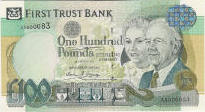AIB (NI) facts for kids
| Division of AIB Group (UK) plc | |
| Founded | 1991 |
| Headquarters | Belfast, Northern Ireland |
|
Key people
|
Adrian Moynihan, Head of AIB – Northern Ireland |
| Products | Various banking products |
AIB (NI) is a bank in Northern Ireland. It used to be known as First Trust Bank. This bank is part of a larger banking group called Allied Irish Banks, specifically its UK branch, AIB Group (UK) plc. AIB (NI) is considered one of the four biggest banks in Ireland.
The bank was created in 1991. This happened when TSB Northern Ireland joined with other parts of the AIB Group. However, the bank's history goes back much further, to 1816, when the Belfast Savings Bank was first started.
For many years, First Trust Bank was one of only four banks allowed to print its own Pound Sterling banknotes in Northern Ireland. This practice stopped in February 2019. First Trust notes are no longer used as official money since June 30, 2022.
In 2010, Allied Irish Banks thought about selling First Trust Bank to raise money. But these plans were later stopped. Instead, the bank announced new investment plans starting in 2014. The bank continued to operate as First Trust Bank in Northern Ireland until November 2019, when it officially became AIB (NI).
What AIB (NI) Does
AIB (NI) is part of the UK division of Allied Irish Banks. This division works in two different areas: Northern Ireland and Great Britain. In Great Britain, it is known as Allied Irish Bank (GB). These two areas have different economies and ways of doing business. AIB Group (UK) p.l.c. is the official company that runs this division. It is based in the UK and follows rules set by the Financial Conduct Authority and the Prudential Regulation Authority.
Northern Ireland Banknotes
Like the other big banks in Northern Ireland, First Trust Bank used to have the right to print its own banknotes. However, they stopped printing new notes on June 30, 2020. These notes were pound sterling notes. Their value was guaranteed by Bank of England notes. It's important not to confuse them with the old banknotes from the former Irish pound.
Before First Trust Bank, earlier versions of the bank also printed notes. These were under names like the Provincial Bank of Ireland Ltd. (until 1976), Allied Irish Banks Ltd. (1977–1986), and Allied Irish Banks PLC (1987–1993).
Designs on First Trust Banknotes
The last banknotes printed by First Trust Bank showed two general people, one male and one female. They appeared as children on the £1 and £5 notes. They looked middle-aged on the £10 and £20 notes. Finally, they were shown as elderly on the £50 and £100 notes.
The front of these notes often featured pictures related to the Spanish Armada. This was to remember when 24 Armada ships crashed off the coast of County Antrim in 1588.
- The £10 note showed the ship Girona.
- The £20 note featured the chimney at Lacada Point, near the Giant's Causeway. This is close to Dunluce, County Antrim, where the Girona ship was wrecked.
- The £50 note displayed a special medal made to remember the event.
- The £100 note showed a general image of the Spanish Armada.
Older £5 notes showed Dunluce Castle on the front. A £1 note also featured the Girona. These were printed by the Provincial Bank of Ireland and AIB, but not by First Trust Bank.
In February 2019, First Trust Bank stopped printing its own banknotes. They began replacing them with Bank of England banknotes as the old ones were returned. First Trust Bank notes could still be used until June 30, 2022. After that date, they were no longer official money. However, you can still put them into bank accounts or swap them for Bank of England notes at AIB (NI) branches.
See also
- Allied Irish Bank (GB)
- Trustee Savings Bank
- Permanent TSB


